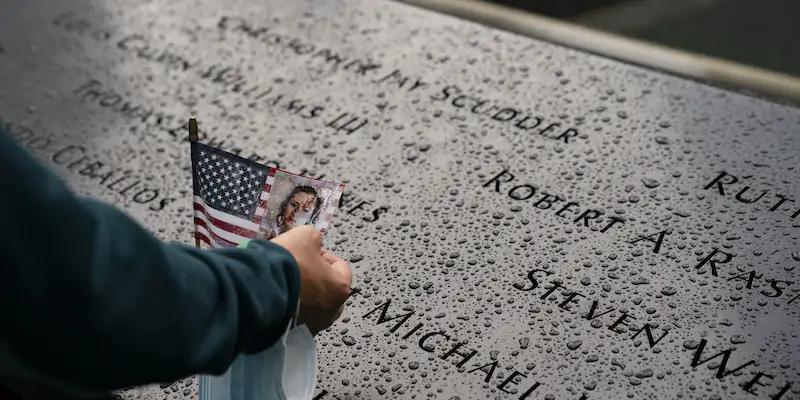Loading player
“Karen, it’s just a bunch of people wanting to advertise. People there pay to talk. ‘ Chris Ferreri remembers trying to persuade Karen Seymour not to go to a conference scheduled for the next day on the 106th floor of the North Tower. The topic was financial technologies, and Seymour thought it would be useful for his job as a computer specialist. Ferreri was his boss: “Really, I want to go,” he said. At that point Ferreri gave up, but recommended that he call if the conference was really interesting.
On September 11, 2001, Seymour left his 3 1/2 year old twin daughters and headed to the conference early in the morning. It would start at nine, but Karen arrived well in advance. Ferreri instead remained in the office where they worked, on the 25th floor, home to a branch of a large financial brokerage agency, ICAP. The conference was never held, because at 8:46 AM the first hijacked Boeing crashed between the 93rd and 99th floors. Ferreri would never hear from Seymour again.
A recent article from the Wall Street Journal has collected stories like this, reconstructed through the testimonies of ICAP employees who survived the attack on the Twin Towers in New York. Other colleagues of Seymour remember how decisions taken in a few moments, in the throes of excitement and panic, then had gigantic repercussions. One choice rather than another, waiting a few minutes or leaving immediately, getting off or up, the morning of September 11 could literally mean the difference between living or dying.
“Apparently minor choices, often made in a confused state, had a huge impact on subsequent experiences and on what happened after,” says Marie Patton, who worked for the ICAP at the time of the attack. “Even today I discover new stories from my colleagues.”
– Read also: The photos of September 11th
In Patton’s case, the choice was when and how quickly to leave the office. She and her colleagues very rarely left their posts. They skipped lunch breaks and fire drills to stay close to a phone at all times – missing a call from a customer could mean missing out on a good deal. They tried to avoid even going to the bathroom. But that morning, Patton was immediately alarmed when he saw the glare caused by the reflection of the glass down from a window on the 25th floor. He realized they must have fallen from the upper floors.
“Someone has to make a fucking decision here,” he remembers screaming. “We have to evacuate, let’s just go, get out!” She and other people headed for the stairs, and on their way down they met some firefighters going up.
Ferreri, on the other hand, moved faster, but not because he understood what was happening. At the moment of the first impact he had just met with an aspiring employee, there for an interview. Ferreri felt the building sway and saw his desk drawers suddenly open. Over the next few minutes he and 25 other ICAP employees made their way to the emergency exit, but without much haste. Ferreri even left his briefcase and cell phone in the office, convinced that he would be back shortly.
Once out, he lost sight of the rest of the group amidst the chaos that had already broken out. He found his colleagues after a while and they headed west, but at that moment they heard a great roar: looking up, Ferreri saw the underside of the second Boeing heading straight towards the South Tower. other attacks, and to have considered jumping into the Hudson River to save himself. Instead he boarded a boat to Staten Island. He was able to return home only in the afternoon, and in the following days he attended 25 funerals of friends and acquaintances, including that of Karen Seymour.
“If I had waited twenty minutes to leave, I probably wouldn’t be here,” says Ferreri. The things he will never forget are the images and the smells. “Each color was transformed from the gray of the ash. In the end it had all turned to ash, all the same color, no matter who or what. ‘
Another employee, Michael Stasinski, recalls that in the moments after the first impact there were some colleagues who did not want to leave. After feeling the shock, he distinctly heard the cables of a nearby elevator snap. At that point he and other security personnel looked out and noticed debris falling from the upper floors. Without wasting any more time, Stasinski and the security staff tried to convince the desk neighbors to form a group and leave, encountering some resistance.
“Listen, you have to go,” he remembers saying. “We won’t go without you.” It was 9:15 am before the persuasion work was successful. The group headed for the stairs, where they joined several other groups. The flow of people was slow, it took them twenty minutes to reach the large mezzanine floor of the tower. Once there, Stasinski heard the warnings from the fire brigade – “Don’t look up!” – and then the thuds on the windows, caused by the people on the top floors who had thrown themselves down.
Among the ICAP employees only Seymour died. The company returned to work less than a week after the attack on the Twin Towers, thanks to the support of competitors who offered temporary spaces and offices to restart its activities. Today, after a series of mergers and acquisitions, it is headquartered in a building opposite the World Trade Center memorial. “I look out the window and there it is,” says Stasinski. “We are reminded of what happened every day. He never forgets ».
– Read also: How New York has changed after 9/11
–


